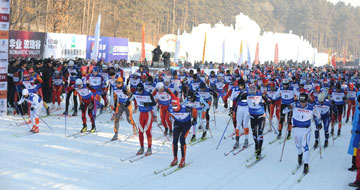The 2013 China Tour de Ski starts on 2 January and is the longest in its six-year-long history. Approximately 80 FIS-licensed skiers are set to embark on a challenging and exciting journey through seven stages, four different locations and three different parts of China. At the end, the men’s and women’s champions will be crowned close to the border with Kazakhstan on 11 January, in the magnificent Nalati grasslands in Xinjiang. Initiated and developed by Nordic Ways, the China Tour de Ski project has reached a new level of maturity this year – and there is more to come.
“With help from the Chinese Ski Association we have managed to create a platform to pitch the best Chinese skiers against seasoned professionals on the global FIS tour,” explains Niclas Hellqvist, Managing Director of Nordic Ways in Beijing. “It is a unique chance for the domestic skiers to test and develop themselves as they do not often have the opportunity to do so in a country where skiing remains a growing but yet small sport. Mind you, there are fast skiers in China: the 2011 edition was won by local skiers both in the men’s as in the women’s. On the other hand, China Tour de Ski also gives Europeans the opportunity to do something different, to race in unfamiliar territory.”
At first, skiers may be hesistant to travel all the way to what still for most people remains a mysterious country, which is eight hours ahead of GMT as well. But after their first experience many are keen to return. Sweden’s Anders Hoegberg, for one, has become a regular on the Tour and as such has made a name for himself in the Far East. Hoegberg has won two editions of China Tour de Ski (2009, 2012) and ended third in another (2011), and scored two victories in the classic-style Vasaloppet China, by far the longest and toughest race of China Tour de Ski. The 36-year-old Hoegberg will once again toe the starting line on the 2nd of January to try and make it three wins in Changchun, but he reportedly will not compete in the other, shorter stages of the Tour this winter.
That means fellow Swede Adam Johansson has one serious rival less to worry about in his attempt to win China Tour de Ski for the second time, after his maiden win in 2010 and second place in 2011. Johansson will face fierce competition from the likes of his own brother Emil Johansson, Finland’s Kusti Kittilae -the runner-up last year -and Mikko Harju, and not in the least from Canada’s double Olympian Drew Goldsack. But as in everything: this is China, when the Tour comes to an end in Xinjiang we may see completely different names topping the result sheets. In fact, the names of the Chinese participants are yet to be confirmed.
In its six-year existence, only Changchun and Xiwuqi have always been part of China Tour de Ski. But skiers have travelled as far south as Shangri La in Yunnan Province to compete in ski sprints at over 3000m altitude. Another extraordinary stop on the Tour was the famous Olympic Bird Nest in Beijing two seasons ago. And now, for the first time, the Far West of China is on the menu with two different stops in Xinjiang: The international ski resort Tianshan Tianchi near the region’s capital city Urumqi, and the Nalati Grassland area in the Yili Kazakh Autonomous Prefecture. A little further north from there is an area called Altai, considered by many to be the cradle of skiing. Not skiing as a sport, but skiing as a means to travel and hunt in the rough and often brutally cold Altai mountain range at the intersection of China, Mongolia, Russia and Kazakhstan. The short and wide Altai skis, used in every-day life by the indigenous people, are a piece of art, indeed.
The 2013 China Tour de Ski is an exciting programme for athletes and followers, but a massive logistical task for the organising crew, too. Upon entering China in Beijing, skiers will immediately go in transit to Changchun, capital of Jilin Province, roughly 1000km up in the North East, and celebrate new year’s eve, which given the ‘positive’ jetlag could be a very long night, indeed. After Vasaloppet China, everyone takes the fast train back to Beijing Capital Airport, and continues for over 600km to Xiwuqi in the northern part of Inner Mongolia. When those two traditional stages are history, a full day of travelling lies ahead as people fly one hour back to Beijing, before flying over three hours west to Urumqi, capital of Xinjiang Uyghur A.R. For the final stages of the Tour, another one-hour flight to Nalati is on the schedule. To give you an idea of the size of China: in Nalati skiers will be 4000km away from Beijing.
As always, the passion for skiing and outdoor sports, as well as promoting the value of healthy living in China, drives Nordic Ways to ensure the 2013 China Tour de Ski will become an unforgettable start of the new year.


 The 2013 China Tour de Ski starts on 2 January and is the longest in its six-year-long history. Approximately 80 FIS-licensed skiers are set to embark on a challenging and exciting journey through seven stages, four different locations and three different parts of China. At the end, the men's and women's champions will be crowned close to the border with Kazakhstan on 11 January, in the magnificent Nalati grasslands in Xinjiang. Initiated and developed by Nordic Ways, the China Tour de Ski project has reached a new level of maturity this year - and there is more to come.
The 2013 China Tour de Ski starts on 2 January and is the longest in its six-year-long history. Approximately 80 FIS-licensed skiers are set to embark on a challenging and exciting journey through seven stages, four different locations and three different parts of China. At the end, the men's and women's champions will be crowned close to the border with Kazakhstan on 11 January, in the magnificent Nalati grasslands in Xinjiang. Initiated and developed by Nordic Ways, the China Tour de Ski project has reached a new level of maturity this year - and there is more to come.